Large-Eddy Simulation of ECN Spray A: Sensitivity Study on Modeling Assumptions
Abstract
1. Introduction
2. Methodology
2.1. Gas Phase Governing Equations
2.2. Subgrid Scale Modeling
2.2.1. Smagorinsky Model
2.2.2. One-Equation Eddy Diffusivity Model (K-Model)
2.2.3. Implicit Model
2.3. Spray Modeling
Secondary Breakup Modeling
3. Numerical Setup
4. Results and Discussion
4.1. Study-I—Cylindrical Injection Volume Dimensions
4.2. Study-II—Breakup Model Comparison
4.3. Study-III—Subgrid Scale Model Comparison
5. Conclusions
- (1)
- Spray metrics are sensitive to the injection cylinder dimensions. The cross-stream dimension of has a stronger influence on the spray characteristics, including spray penetration lengths, momentum intensity, and droplets evaporation.
- (2)
- The no-breakup model approach performs equally well compared with the tuned KHRT model.
- (3)
- With respect to global spray metrics, the no-breakup model approach is shown to be insensitive to the chosen SGS closure model.
- (4)
- According to statistical analyses on mixing indicators, explicit SGS models predict a wider range of scalar dissipation rates in coarse resolution regions compared with the ILES.
- (5)
- According to the PSD analysis, dampened energy spectra in the lower frequency range, which correspond to larger length scales by Taylor’s hypothesis, are produced by the Smagorinsky SGS model compared with the K-model and the ILES.
Author Contributions
Funding
Acknowledgments
Conflicts of Interest
Abbreviations
| LES | large-eddy simulation |
| ECN | Engine Combustion Network |
| LPT | Lagrangian particle tracking |
| SGS | subgrid scales |
| CI | compression ignition |
| Weber number | |
| LSM | level-set method |
| VoF | volume of fluid |
| ILES | implicit large-eddy simulation |
| SMD | Sauter mean diameter |
| Stokes number | |
| SCR | selective catalytic reduction |
| RANS | Reynolds-averaged Navier–Stokes |
| KHRT | Kelvin-Helmholtz Rayleigh-Taylor |
| ETAB | enhanced Taylor analogy breakup |
| FVM | finite volume method |
| PISO | Pressure-Implicit with Splitting of Operator |
| TVD | total variation diminishing |
| IDSD | initial droplet size distribution |
| KH | Kelvin–Helmholtz |
| RT | Rayleigh-Taylor |
| DBI | diffused back-illumination |
| probability density function | |
| SOI | start of injection |
| PSD | power spectral density |
| kinetic energy |
Appendix A. Spray Half Cone Angle Variational Effects

References
- Law, C. Recent advances in droplet vaporization and combustion. Prog. Energy Combust. Sci. 1982, 8, 171–201. [Google Scholar] [CrossRef]
- Sirignano, W.A. Fuel droplet vaporization and spray combustion theory. Prog. Energy Combust. Sci. 1983, 9, 291–322. [Google Scholar] [CrossRef]
- Wierzba, A.; Takayama, K. Experimental investigation of the aerodynamic breakup of liquid drops. AIAA J. 1988, 26, 1329–1335. [Google Scholar] [CrossRef]
- Faeth, G. Structure and atomization properties of dense turbulent sprays. Symp. Int. Combust. 1991, 23, 1345–1352. [Google Scholar] [CrossRef]
- Phinney, R.E. The breakup of a turbulent liquid jet in a gaseous atmosphere. J. Fluid Mech. 1973, 60, 689–701. [Google Scholar] [CrossRef]
- Hoyt, J.W.; Taylor, J.J. Turbulence structure in a water jet discharging in air. Phys. Fluids 1977, 20, S253. [Google Scholar] [CrossRef]
- Hoyt, J.W.; Taylor, J.J. Waves on water jets. J. Fluid Mech. 1977, 83, 119–127. [Google Scholar] [CrossRef]
- Chehroudi, B.; Chen, S.H.; Bracco, F.V.; Onuma, Y. On the intact core of full-cone sprays. SAE Trans. 1985, 764–773. [Google Scholar] [CrossRef]
- Siebers, D.L. Liquid-Phase Fuel Penetration in Diesel Sprays; SAE Technical Paper Series; SAE International: Warrendale, PA, USA, 1998. [Google Scholar] [CrossRef]
- O’Rourke, P.J.; Amsden, A.A. The TAB Method for Numerical Calculation of Spray Droplet Breakup; SAE Technical Paper Series; SAE International: Warrendale, PA, USA, 1987. [Google Scholar] [CrossRef]
- Wierzba, A. Deformation and breakup of liquid drops in a gas stream at nearly critical Weber numbers. Exp. Fluids 1990, 9, 59–64. [Google Scholar] [CrossRef]
- Ménard, T.; Tanguy, S.; Berlemont, A. Coupling level set/VOF/ghost fluid methods: Validation and application to 3D simulation of the primary break-up of a liquid jet. Int. J. Multiph. Flow 2007, 33, 510–524. [Google Scholar] [CrossRef]
- de Villiers, E.; Gosman, A.; Weller, H. Large eddy simulation of primary diesel spray atomization. SAE Trans. 2004, 113, 193–206. [Google Scholar]
- Xue, Q.; Battistoni, M.; Powell, C.; Longman, D.; Quan, S.; Pomraning, E.; Senecal, P.; Schmidt, D.; Som, S. An Eulerian CFD model and X-ray radiography for coupled nozzle flow and spray in internal combustion engines. Int. J. Multiph. Flow 2015, 70, 77–88. [Google Scholar] [CrossRef]
- Bravo, L.; Xue, Q.; Som, S.; Powell, C.; Kweon, C.B.M. Fuel Effects on Nozzle Flow and Spray Using Fully Coupled Eulerian Simulations. In Proceedings of the ASME 2015 Power Conference, San Diego, CA, USA, 28 June–2 July 2015; American Society of Mechanical Engineers: New York, NY, USA, 2015. [Google Scholar] [CrossRef]
- Trujillo, M.F.; Gurjar, S.; Mason, M.; Agarwal, A. Global characterization of the spray formation process. Atomiz. Sprays 2018, 28, 811–835. [Google Scholar] [CrossRef]
- Shinjo, J. Recent Advances in Computational Modeling of Primary Atomization of Liquid Fuel Sprays. Energies 2018, 11, 2971. [Google Scholar] [CrossRef]
- Rutland, C.J. Large-eddy simulations for internal combustion engines—A review. Int. J. Eng. Res. 2011, 12, 421–451. [Google Scholar] [CrossRef]
- Sanjosé, M.; Senoner, J.; Jaegle, F.; Cuenot, B.; Moreau, S.; Poinsot, T. Fuel injection model for Euler–Euler and Euler–Lagrange large-eddy simulations of an evaporating spray inside an aeronautical combustor. Int. J. Multiph. Flow 2011, 37, 514–529. [Google Scholar] [CrossRef]
- Kaario, O.; Vuorinen, V.; Zhu, L.; Larmi, M.; Liu, R. Mixing and evaporation analysis of a high-pressure SCR system using a hybrid LES-RANS approach. Energy 2017, 120, 827–841. [Google Scholar] [CrossRef]
- Kaario, O.; Vuorinen, V.; Kahila, H.; Im, H.G.; Larmi, M. The effect of fuel on high velocity evaporating fuel sprays: Large-eddy simulation of Spray A with various fuels. Int. J. Eng. Res. 2019, 21, 26–42. [Google Scholar] [CrossRef]
- Apte, S.; Gorokhovski, M.; Moin, P. LES of atomizing spray with stochastic modeling of secondary breakup. Int. J. Multiph. Flow 2003, 29, 1503–1522. [Google Scholar] [CrossRef]
- Vuorinen, V.; Larmi, M.; Antila, E.; Kaario, O.; El-Hannouny, E.; Gupta, S. Near Nozzle Diesel Spray Modeling and X-ray Measurements; SAE Technical Paper Series; SAE International: Warrendale, PA, USA, 2006. [Google Scholar] [CrossRef]
- Vuorinen, V.; Larmi, M.; Fuchs, L. Large eddy simulation of spray-originated turbulence production and dissipation. In Proceedings of the 6th International Conference on Multiphase Flow, Leipzig, Germany, 9–13 July 2007. [Google Scholar]
- Bharadwaj, N.; Rutland, C.J.; Chang, S. Large eddy simulation modelling of spray-induced turbulence effects. Int. J. Eng. Res. 2009, 10, 97–119. [Google Scholar] [CrossRef]
- Salewski, M.; Fuchs, L. Consistency issues of Lagrangian particle tracking applied to a spray jet in crossflow. Int. J. Multiph. Flow 2007, 33, 394–410. [Google Scholar] [CrossRef]
- Vuorinen, V.; Larmi, M.; Fuchs, L. Large-Eddy Simulation on the Effect of Droplet Size Distribution on Mixing of Passive Scalar in a Spray; SAE Technical Paper Series; SAE International: Warrendale, PA, USA, 2008. [Google Scholar] [CrossRef]
- Vuorinen, V.; Larmi, M.; Fuchs, L. Large-eddy simulation of particle size distribution effects on turbulence in sprays. In Proceedings of the 46th AIAA Aerospace Sciences Meeting and Exhibit, Reno, NV, USA, 7–10 January 2008; American Institute of Aeronautics and Astronautics: Reston, VA, USA, 2008. [Google Scholar] [CrossRef]
- Vuorinen, V.; Hillamo, H.; Kaario, O.; Larmi, M.; Fuchs, L. Large eddy simulation of droplet Stokes number effects on turbulent spray shape. Atomiz. Sprays 2010, 20, 93–114. [Google Scholar] [CrossRef]
- Vuorinen, V.; Hillamo, H.; Kaario, O.; Nuutinen, M.; Larmi, M.; Fuchs, L. Large eddy simulation of droplet Stokes number effects on mixture quality in fuel sprays. Atomiz. Sprays 2010, 20, 435–451. [Google Scholar] [CrossRef]
- Vuorinen, V.; Hillamo, H.; Kaario, O.; Nuutinen, M.; Larmi, M.; Fuchs, L. Effect of droplet size and atomization on spray formation: A priori study using large-eddy simulation. Flow Turbul. Combust. 2010, 86, 533–561. [Google Scholar] [CrossRef]
- Kaario, O.; Hulkkonen, T.; Vuorinen, V.; Wehrfritz, A.; Keskinen, K.; Larmi, M. Numerical and experimental investigation of fuel spray behaviour in very high density environment using LES. In Proceedings of the ICLASS 2012, 12th Triennial International Conference on Liquid Atomization and Spray Systems, Heidelberg, Germany, 2–6 September 2012. [Google Scholar]
- Kaario, O.; Vuorinen, V.; Hulkkonen, T.; Keskinen, K.; Nuutinen, M.; Larmi, M.; Tanner, F.X. Large eddy simulation of high gas density effects in fuel sprays. Atomiz. Sprays 2013, 23, 297–325. [Google Scholar] [CrossRef]
- Wehrfritz, A.; Vuorinen, V.; Kaario, O.; Larmi, M. Large eddy simulation of high-velocity fuel sprays: Studying mesh resolution and breakup model effects for Spray A. Atomiz. Sprays 2013, 23, 419–442. [Google Scholar] [CrossRef]
- Xue, Q.; Som, S.; Senecal, P.K.; Pomraning, E. Large eddy simulation of fuel-spray under non-reacting IC engine conditions. Atomiz. Sprays 2013, 23, 925–955. [Google Scholar] [CrossRef]
- Tsang, C.W.; Kuo, C.W.; Trujillo, M.; Rutland, C. Evaluation and validation of large-eddy simulation sub-grid spray dispersion models using high-fidelity volume-of-fluid simulation data and engine combustion network experimental data. Int. J. Eng. Res. 2018, 20, 583–605. [Google Scholar] [CrossRef]
- Senecal, P.K.; Pomraning, E.; Xue, Q.; Som, S.; Banerjee, S.; Hu, B.; Liu, K.; Deur, J.M. Large Eddy Simulation of Vaporizing Sprays Considering Multi-Injection Averaging and Grid-Convergent Mesh Resolution. J. Eng. Gas Turbines Power 2014, 136. [Google Scholar] [CrossRef]
- Pei, Y.; Davis, M.J.; Pickett, L.M.; Som, S. Engine Combustion Network (ECN): Global sensitivity analysis of Spray A for different combustion vessels. Combust. Flame 2015, 162, 2337–2347. [Google Scholar] [CrossRef]
- Solsjö, R.; Bai, X.S. Injection of Fuel at High Pressure Conditions: LES Study; SAE Technical Paper Series; SAE International: Warrendale, PA, USA, 2011. [Google Scholar] [CrossRef]
- Gong, C.; Jangi, M.; Lucchini, T.; D’Errico, G.; Bai, X.S. Large Eddy Simulation of Air Entrainment and Mixing in Reacting and Non-Reacting Diesel Sprays. Flow Turbul. Combust. 2014, 93, 385–404. [Google Scholar] [CrossRef]
- Koukouvinis, P.; Vidal-Roncero, A.; Rodriguez, C.; Gavaises, M.; Pickett, L. High pressure/high temperature multiphase simulations of dodecane injection to nitrogen: Application on ECN Spray-A. Fuel 2020, 275, 117871. [Google Scholar] [CrossRef]
- Matheis, J.; Hickel, S. Multi-component vapor-liquid equilibrium model for LES of high-pressure fuel injection and application to ECN Spray A. Int. J. Multiph. Flow 2018, 99, 294–311. [Google Scholar] [CrossRef]
- Yang, S.; Yi, P.; Habchi, C. Real-fluid injection modeling and LES simulation of the ECN Spray A injector using a fully compressible two-phase flow approach. Int. J. Multiph. Flow 2020, 122, 103145. [Google Scholar] [CrossRef]
- Jangi, M.; D’Errico, G.; Bai, X.S.; Lucchini, T. Numerical Simulation of the ECN Spray A Using Multidimensional Chemistry Coordinate Mapping: N-Dodecane Diesel Combustion; SAE Technical Paper Series; SAE International: Warrendale, PA, USA, 2012. [Google Scholar] [CrossRef]
- Pei, Y.; Hawkes, E.R.; Kook, S.; Goldin, G.M.; Lu, T. Modelling n-dodecane spray and combustion with the transported probability density function method. Combust. Flame 2015, 162, 2006–2019. [Google Scholar] [CrossRef]
- Pei, Y.; Som, S.; Pomraning, E.; Senecal, P.K.; Skeen, S.A.; Manin, J.; Pickett, L.M. Large eddy simulation of a reacting spray flame with multiple realizations under compression ignition engine conditions. Combust. Flame 2015, 162, 4442–4455. [Google Scholar] [CrossRef]
- Jangi, M.; Solsjo, R.; Johansson, B.; Bai, X.S. On large eddy simulation of diesel spray for internal combustion engines. Int. J. Heat Fluid Flow 2015, 53, 68–80. [Google Scholar] [CrossRef]
- Blomberg, C.K.; Zeugin, L.; Pandurangi, S.S.; Bolla, M.; Boulouchos, K.; Wright, Y.M. Modeling Split Injections of ECN “Spray A” Using a Conditional Moment Closure Combustion Model with RANS and LES. SAE Int. J. Eng. 2016, 9, 2107–2119. [Google Scholar] [CrossRef]
- Fang, X.H.; Ismail, R.; Bushe, K.; Davy, M. Simulation of ECN diesel spray A using conditional source-term estimation. Combust. Theory Model. 2020, 1–36. [Google Scholar] [CrossRef]
- Dalakoti, D.K.; Savard, B.; Hawkes, E.R.; Wehrfritz, A.; Wang, H.; Day, M.S.; Bell, J.B. Direct numerical simulation of a spatially developing n-dodecane jet flame under Spray A thermochemical conditions: Flame structure and stabilisation mechanism. Combust. Flame 2020, 217, 57–76. [Google Scholar] [CrossRef]
- Chishty, M.A.; Bolla, M.; Hawkes, E.; Pei, Y.; Kook, S. Assessing the Importance of Radiative Heat Transfer for ECN Spray A Using the Transported PDF Method. SAE Int. J. Fuels Lubr. 2016, 9, 100–107. [Google Scholar] [CrossRef]
- Krisman, A.; Hawkes, E.R.; Chen, J.H. A parametric study of ignition dynamics at ECN Spray A thermochemical conditions using 2D DNS. Proc. Combust. Inst. 2019, 37, 4787–4795. [Google Scholar] [CrossRef]
- Wehrfritz, A.; Kaario, O.; Vuorinen, V.; Somers, B. Large Eddy Simulation of n-dodecane spray flames using Flamelet Generated Manifolds. Combust. Flame 2016, 167, 113–131. [Google Scholar] [CrossRef]
- Kahila, H.; Wehrfritz, A.; Kaario, O.; Masouleh, M.G.; Maes, N.; Somers, B.; Vuorinen, V. Large-eddy simulation on the influence of injection pressure in reacting Spray A. Combust. Flame 2018, 191, 142–159. [Google Scholar] [CrossRef]
- Kahila, H.; Wehrfritz, A.; Kaario, O.; Vuorinen, V. Large-eddy simulation of dual-fuel ignition: Diesel spray injection into a lean methane-air mixture. Combust. Flame 2019, 199, 131–151. [Google Scholar] [CrossRef]
- Tekgül, B.; Kahila, H.; Kaario, O.; Vuorinen, V. Large-eddy simulation of dual-fuel spray ignition at different ambient temperatures. Combust. Flame 2020, 215, 51–65. [Google Scholar] [CrossRef]
- Kahila, H.; Kaario, O.; Ahmad, Z.; Masouleh, M.G.; Tekgül, B.; Larmi, M.; Vuorinen, V. A large-eddy simulation study on the influence of diesel pilot spray quantity on methane-air flame initiation. Combust. Flame 2019, 206, 506–521. [Google Scholar] [CrossRef]
- Pickett, L.M.; Manin, J.; Kastengren, A.; Powell, C. Comparison of Near-Field Structure and Growth of a Diesel Spray Using Light-Based Optical Microscopy and X-Ray Radiography. SAE Int. J. Eng. 2014, 7, 1044–1053. [Google Scholar] [CrossRef]
- Payri, F.; Payri, R.; Bardi, M.; Carreres, M. Engine combustion network: Influence of the gas properties on the spray penetration and spreading angle. Exp. Therm. Fluid Sci. 2014, 53, 236–243. [Google Scholar] [CrossRef]
- Kastengren, A.L.; Tilocco, F.Z.; Duke, D.J.; Powell, C.F.; Zhang, X.; Moon, S. Time-resolved x-ray radiography of sprays from Engine Combustion Network Spray A diesel injectors. Atomiz. Sprays 2014, 24, 251–272. [Google Scholar] [CrossRef]
- Daly, S.; Cenker, E.; Pickett, L.; Skeen, S. The Effects of Injector Temperature on Spray Characteristics in Heavy-Duty Diesel Sprays. SAE Int. J. Eng. 2018, 11, 879–891. [Google Scholar] [CrossRef]
- Payri, R.; Viera, J.P.; Gopalakrishnan, V.; Szymkowicz, P.G. The effect of nozzle geometry over the evaporative spray formation for three different fuels. Fuel 2017, 188, 645–660. [Google Scholar] [CrossRef]
- Agarwal, A.; Trujillo, M.F. The effect of nozzle internal flow on spray atomization. Int. J. Eng. Res. 2019, 21, 55–72. [Google Scholar] [CrossRef]
- Falgout, Z.; Rahm, M.; Wang, Z.; Linne, M. Evidence for supercritical mixing layers in the ECN Spray A. Proc. Combust. Inst. 2015, 35, 1579–1586. [Google Scholar] [CrossRef]
- Dahms, R.N.; Manin, J.; Pickett, L.M.; Oefelein, J.C. Understanding high-pressure gas-liquid interface phenomena in Diesel engines. Proc. Combust. Inst. 2013, 34, 1667–1675. [Google Scholar] [CrossRef]
- Dahms, R.N.; Oefelein, J.C. On the transition between two-phase and single-phase interface dynamics in multicomponent fluids at supercritical pressures. Phys. Fluids 2013, 25, 092103. [Google Scholar] [CrossRef]
- Manin, J.; Bardi, M.; Pickett, L.; Dahms, R.; Oefelein, J. Microscopic investigation of the atomization and mixing processes of diesel sprays injected into high pressure and temperature environments. Fuel 2014, 134, 531–543. [Google Scholar] [CrossRef]
- Dahms, R.N.; Oefelein, J.C. Liquid jet breakup regimes at supercritical pressures. Combust. Flame 2015, 162, 3648–3657. [Google Scholar] [CrossRef]
- Dahms, R.N.; Oefelein, J.C. Non-equilibrium gas–liquid interface dynamics in high-pressure liquid injection systems. Proc. Combust. Inst. 2015, 35, 1587–1594. [Google Scholar] [CrossRef]
- Crua, C.; Manin, J.; Pickett, L.M. On the transcritical mixing of fuels at diesel engine conditions. Fuel 2017, 208, 535–548. [Google Scholar] [CrossRef]
- Jung, Y.; Manin, J.; Skeen, S.; Pickett, L.M. Measurement of Liquid and Vapor Penetration of Diesel Sprays with a Variation in Spreading Angle; SAE Technical Paper Series; SAE International: Warrendale, PA, USA, 2015. [Google Scholar] [CrossRef]
- Payri, R.; García-Oliver, J.M.; Xuan, T.; Bardi, M. A study on diesel spray tip penetration and radial expansion under reacting conditions. Appl. Therm. Eng. 2015, 90, 619–629. [Google Scholar] [CrossRef]
- Maes, N.; Dam, N.; Somers, B.; Lucchini, T.; D’Errico, G.; Hardy, G. Experimental and Numerical Analyses of Liquid and Spray Penetration under Heavy-Duty Diesel Engine Conditions. SAE Int. J. Fuels Lubr. 2016, 9, 108–124. [Google Scholar] [CrossRef]
- Maes, N.; Meijer, M.; Dam, N.; Somers, B.; Toda, H.B.; Bruneaux, G.; Skeen, S.A.; Pickett, L.M.; Manin, J. Characterization of Spray A flame structure for parametric variations in ECN constant-volume vessels using chemiluminescence and laser-induced fluorescence. Combust. Flame 2016, 174, 138–151. [Google Scholar] [CrossRef]
- Weller, H.G.; Tabor, G.; Jasak, H.; Fureby, C. A tensorial approach to computational continuum mechanics using object-oriented techniques. Comput. Phys. 1998, 12, 620. [Google Scholar] [CrossRef]
- Issa, R.; Ahmadi-Befrui, B.; Beshay, K.; Gosman, A. Solution of the implicitly discretised reacting flow equations by operator-splitting. J. Comput. Phys. 1991, 93, 388–410. [Google Scholar] [CrossRef]
- Smagorinsky, J. General circulation experiments with the primitive equations. Mon. Weather Rev. 1963, 91, 99–164. [Google Scholar] [CrossRef]
- Yoshizawa, A. Statistical theory for compressible turbulent shear flows, with the application to subgrid modeling. Phys. Fluids 1986, 29, 2152. [Google Scholar] [CrossRef]
- Jasak, H.; Weller, H.; Gosman, A. High resolution NVD differencing scheme for arbitrarily unstructured meshes. Int. J. Num. Methods Fluids 1999, 31, 431–449. [Google Scholar] [CrossRef]
- Elghobashi, S. On predicting particle-laden turbulent flows. Appl. Sci. Res. 1994, 52, 309–329. [Google Scholar] [CrossRef]
- Zuo, B.; Gomes, A.; Rutland, C. Studies of superheated fuel spray structures and vaporization in GDI engines. In Proceedings of the Eleventh International Multidimensional Engine Modeling User’s Group Meeting, Detroit, MI, USA, 4 March 2000. [Google Scholar]
- Putnam, A. Integratable form of droplet drag coefficient. ARS J. 1961, 31, 1467–1468. [Google Scholar]
- Ranz, W.; Marshall, W. Evaporation from drops. Chem. Eng. Prog. 1952, 48, 141–146. [Google Scholar]
- Vesilind, P. The Rosin-Rammler particle size distribution. Resour. Recovery Conserv. 1980, 5, 275–277. [Google Scholar] [CrossRef]
- Bode, M.; Davidovic, M.; Pitsch, H. Multi-scale coupling for predictive injector simulations. In Lecture Notes in Computer Science; Springer International Publishing: Cham, Switzerland, 2017; pp. 96–108. [Google Scholar] [CrossRef]
- Crua, C.; Stetsyuk, V.; de Sercey, G.; Turner, J. Droplet and liquid size measurements in the near-nozzle region. In Proceedings of the Engine Combustion Network 4th Workshop, ECN4, Kyoto, Japan, 5–6 September 2015. [Google Scholar]
- Kastengren, A.; Ilavsky, J.; Viera, J.P.; Payri, R.; Duke, D.; Swantek, A.; Tilocco, F.Z.; Sovis, N.; Powell, C. Measurements of droplet size in shear-driven atomization using ultra-small angle x-ray scattering. Int. J. Multiph. Flow 2017, 92, 131–139. [Google Scholar] [CrossRef]
- Payri, R.; Salvador, F.; Gimeno, J.; Bracho, G. A new methodology for correcting the signal cumulative phenomenon on injection rate measurements. Exp. Tech. 2008, 32, 46–49. [Google Scholar] [CrossRef]
- Reitz, R.D. Modeling atomization processes in high-pressure vaporizing sprays. Atomisat. Spray Technol. 1987, 3, 309–337. [Google Scholar]
- Tanner, F.X. Liquid jet atomization and droplet breakup modeling of non-evaporating diesel fuel sprays. SAE Trans. 1997, 106, 127–140. [Google Scholar]
- Xin, J.; Ricart, L.; Reitz, R. Computer modeling of diesel spray atomization and combustion. Combust. Sci. Technol. 1998, 137, 171–194. [Google Scholar] [CrossRef]
- Reitz, R.D.; Beale, J.C. Modeling spray atomization with the Kelvin-Helmholtz/Rayleigh-Taylor Hybrid model. Atomiz. Sprays 1999, 9, 623–650. [Google Scholar] [CrossRef]
- Kärrholm, F.P.; Nordin, N. Numerical Investigation of Mesh/Turbulence/Spray Interaction for Diesel Applications; SAE Technical Paper Series; SAE International: Warrendale, PA, USA, 2005. [Google Scholar] [CrossRef]
- Kärrholm, F.P.; Weller, H.; Nordin, N. Modelling Injector Flow Including Cavitation Effects for Diesel Applications; Volume 2: Fora, Parts A and B; ASMEDC: New York, NY, USA, 2007. [Google Scholar] [CrossRef]
- Pickett, L.M.; Abraham, J.P. Computed and measured fuel vapor distribution in a diesel spray. Atomiz. Sprays 2010, 20, 241–250. [Google Scholar] [CrossRef]
- Pickett, L.M.; Genzale, C.L.; Manin, J. Uncertainty quantification for liquid penetration of evaporating sprays at diesel-like conditions. Atomiz. Sprays 2015, 25, 425–452. [Google Scholar] [CrossRef]
- Payri, R.; Salvador, F.J.; Gimeno, J.; de la Morena, J. Macroscopic behavior of diesel sprays in the near-nozzle field. SAE Int. J. Eng. 2008, 1, 528–536. [Google Scholar] [CrossRef]
- Idicheria, C.A.; Pickett, L.M. Quantitative Mixing Measurements in a Vaporizing Diesel Spray by Rayleigh Imaging; SAE World Congress & Exhibition; SAE International: Warrendale, PA, USA, 2007. [Google Scholar] [CrossRef]
- Pickett, L.M.; Manin, J.; Genzale, C.L.; Siebers, D.L.; Musculus, M.P.B.; Idicheria, C.A. Relationship between diesel fuel spray vapor penetration/dispersion and local fuel mixture fraction. SAE Int. J. Eng. 2011, 4, 764–799. [Google Scholar] [CrossRef]
- Magnotti, G.; Genzale, C. Detailed assessment of diesel spray atomization models using visible and X-ray extinction measurements. Int. J. Multiph. Flow 2017, 97, 33–45. [Google Scholar] [CrossRef]
- Pandal, A.; Payri, R.; García-Oliver, J.; Pastor, J. Optimization of spray break-up CFD simulations by combining Σ-Y Eulerian atomization model with a response surface methodology under diesel engine-like conditions (ECN Spray A). Comput. Fluids 2017, 156, 9–20. [Google Scholar] [CrossRef]
- Pitsch, H.; Steiner, H. Scalar mixing and dissipation rate in large-eddy simulations of non-premixed turbulent combustion. Proc. Combust. Inst. 2000, 28, 41–49. [Google Scholar] [CrossRef]
- Khani, S.; Waite, M.L. Buoyancy scale effects in large-eddy simulations of stratified turbulence. J. Fluid Mech. 2014, 754, 75–97. [Google Scholar] [CrossRef]
- Khani, S. Mixing efficiency in large-eddy simulations of stratified turbulence. J. Fluid Mech. 2018, 849, 373–394. [Google Scholar] [CrossRef]
- Welch, P. The use of fast Fourier transform for the estimation of power spectra: A method based on time averaging over short, modified periodograms. IEEE Trans. Audio Electr. 1967, 15, 70–73. [Google Scholar] [CrossRef]
- Ha, Y.H.; Pearce, J. A new window and comparison to standard windows. IEEE Trans. Acoust. Speech Signal Proc. 1989, 37, 298–301. [Google Scholar] [CrossRef]
- Taylor, G.I. The spectrum of turbulence. Proc. R. Soc. Lond. Ser. A Math. Phys. Sci. 1938, 164, 476–490. [Google Scholar] [CrossRef]
- Kolmogorov, A.N. The local structure of turbulence in incompressible viscous fluid for very large Reynolds numbers. C. R. Acad. Sci. URSS 1941, 30, 301–305. [Google Scholar]
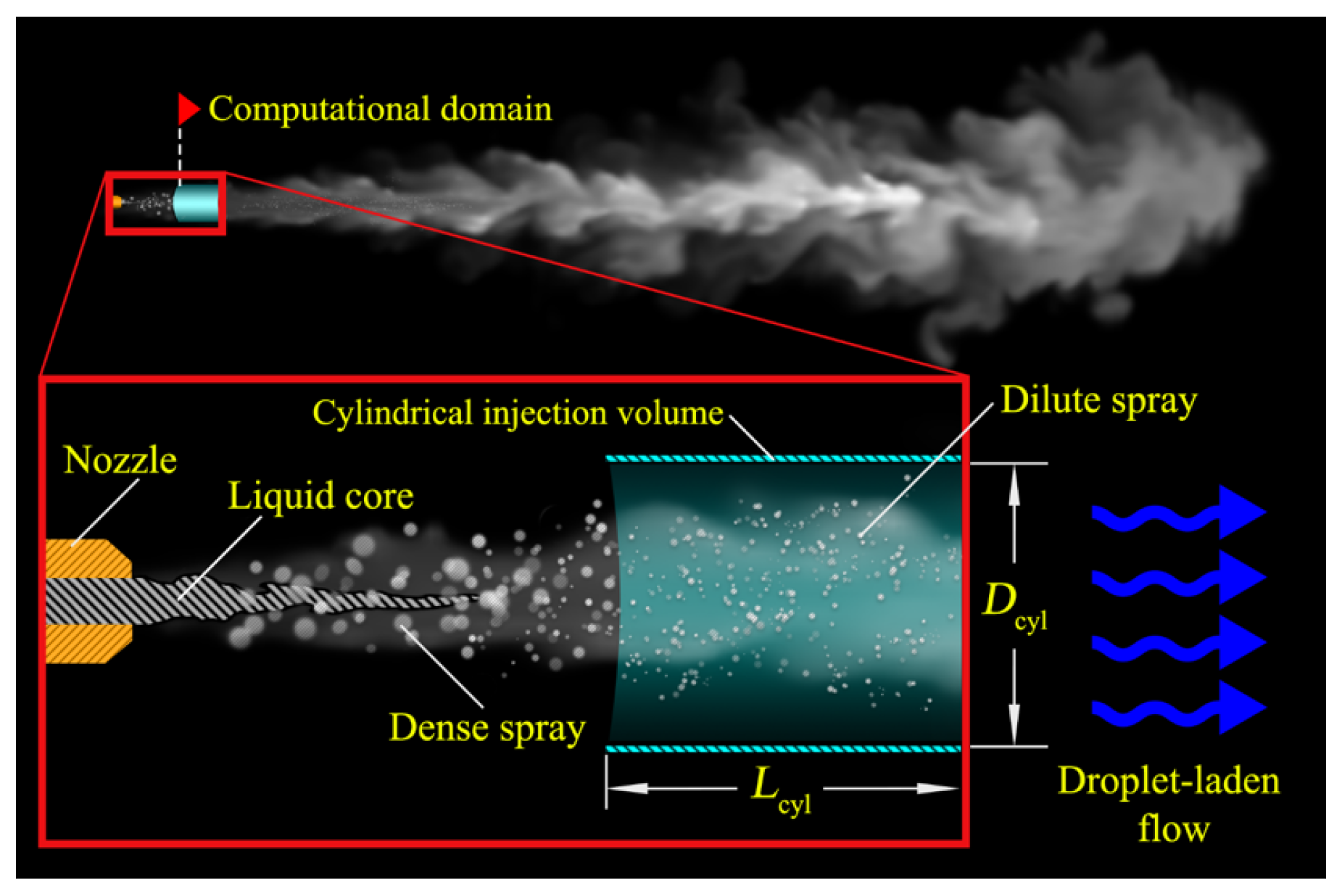

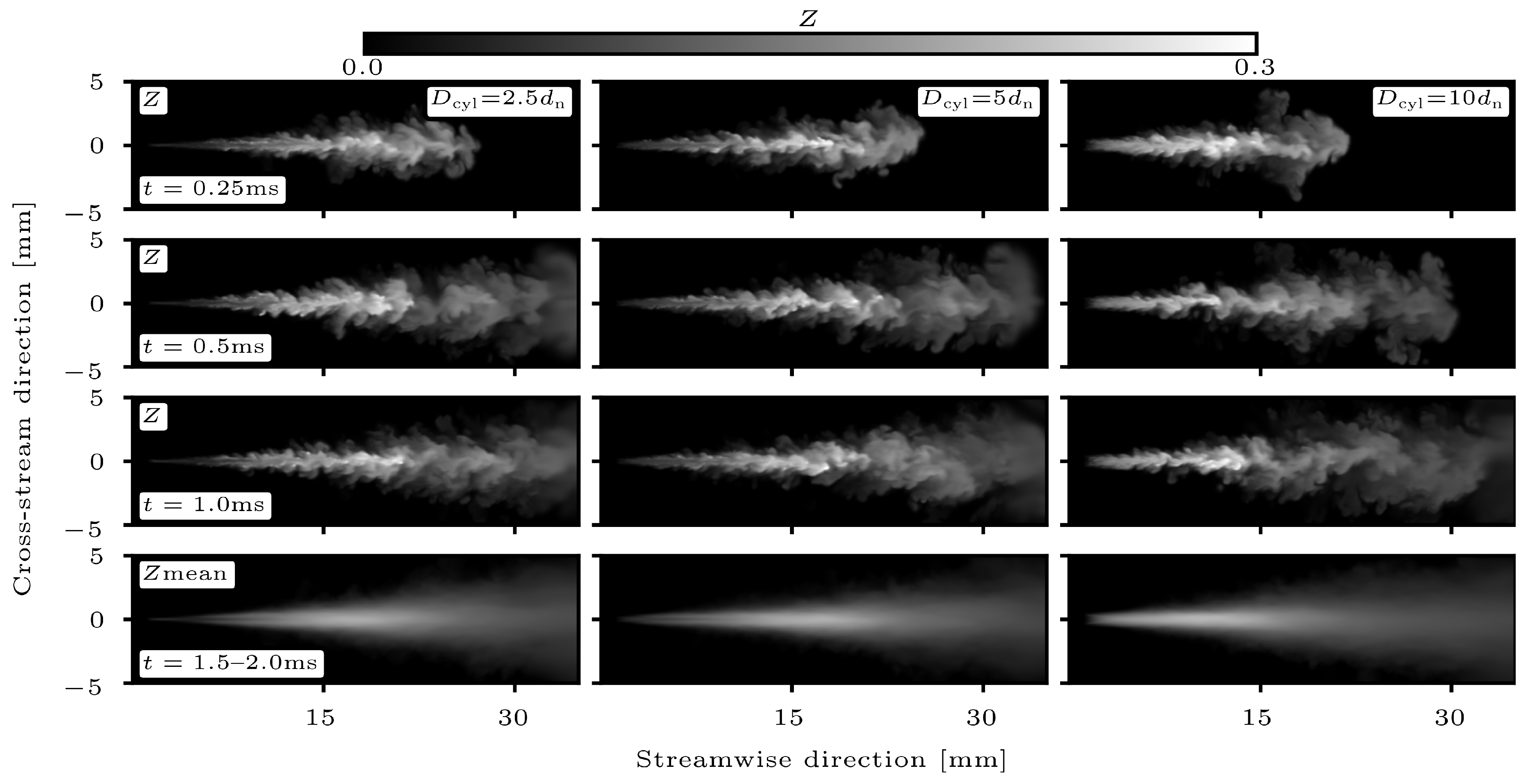
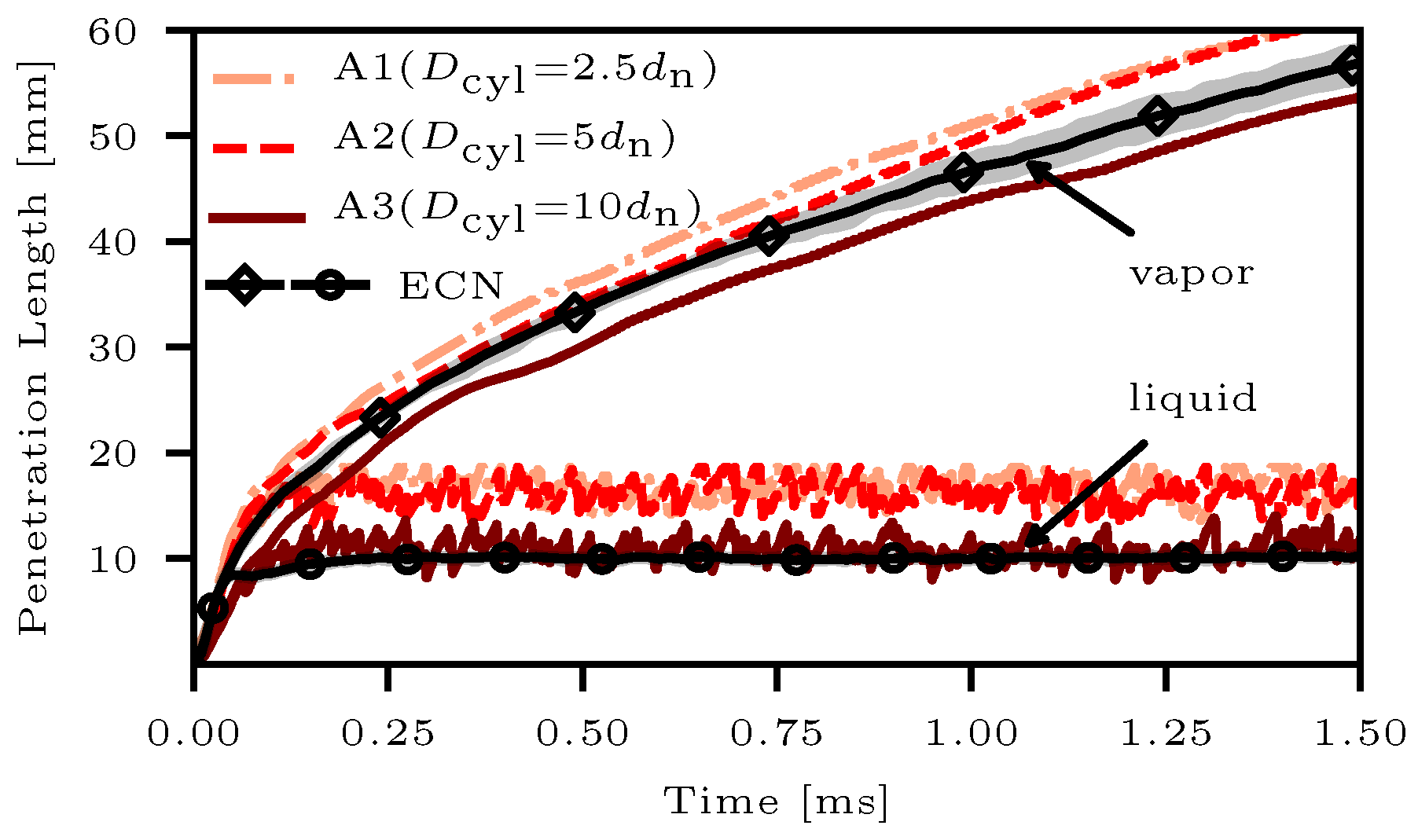
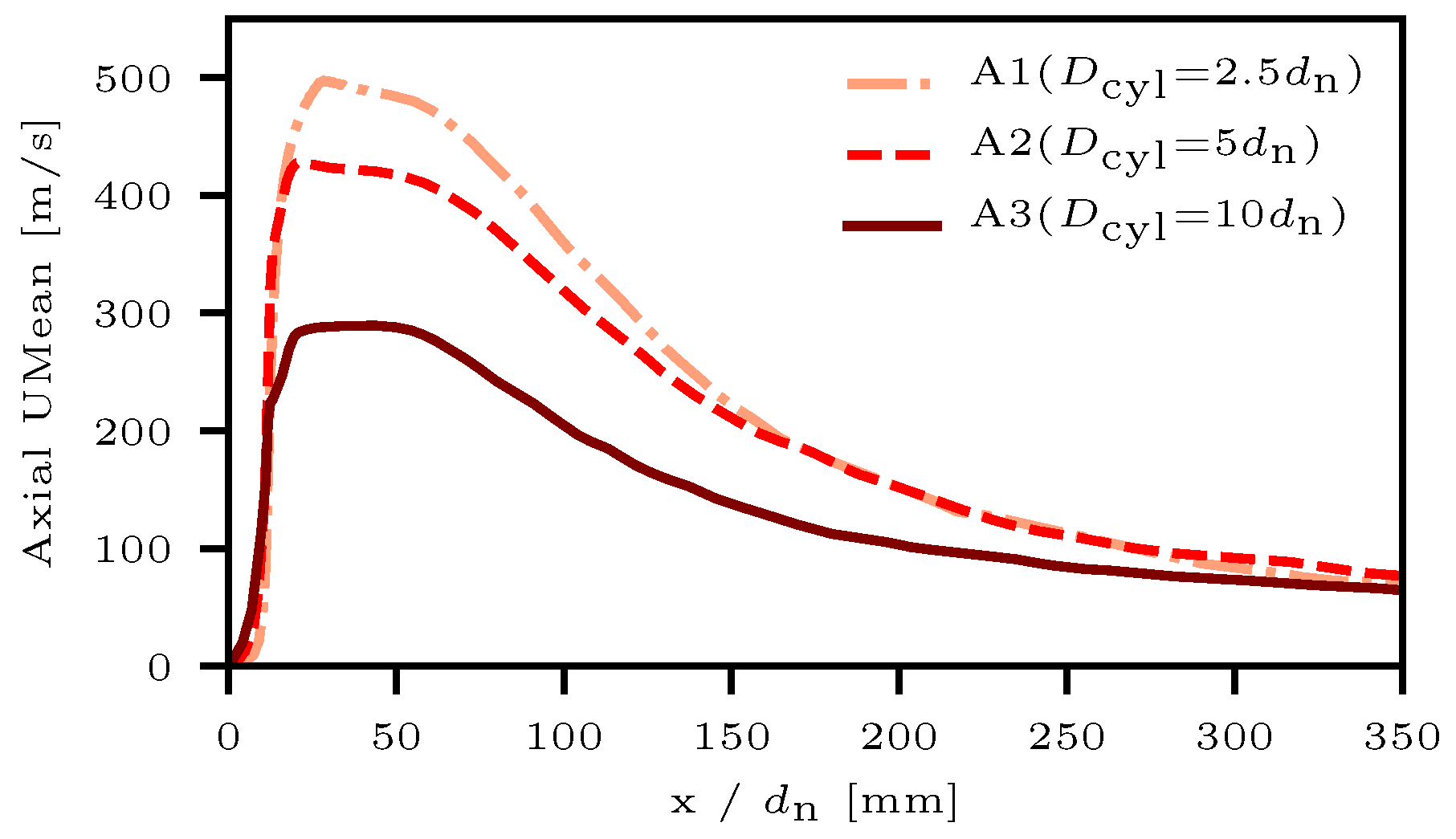
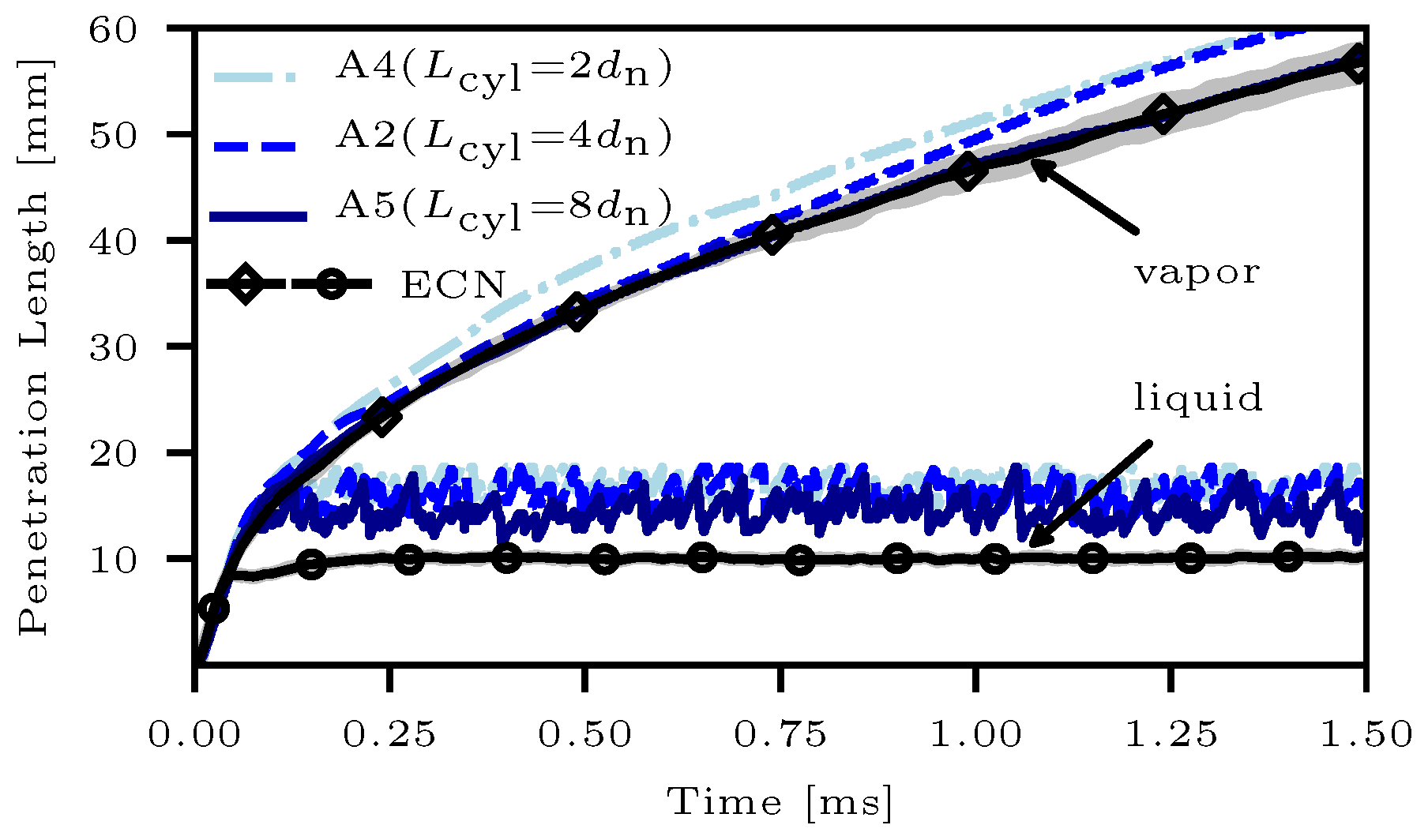
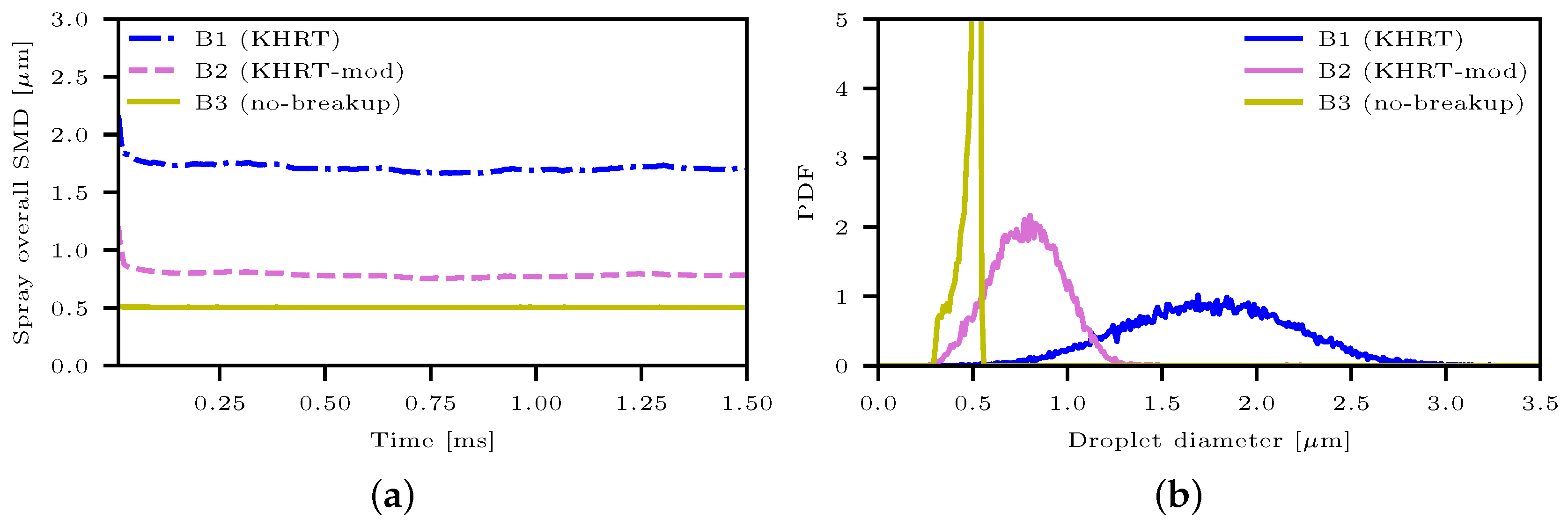
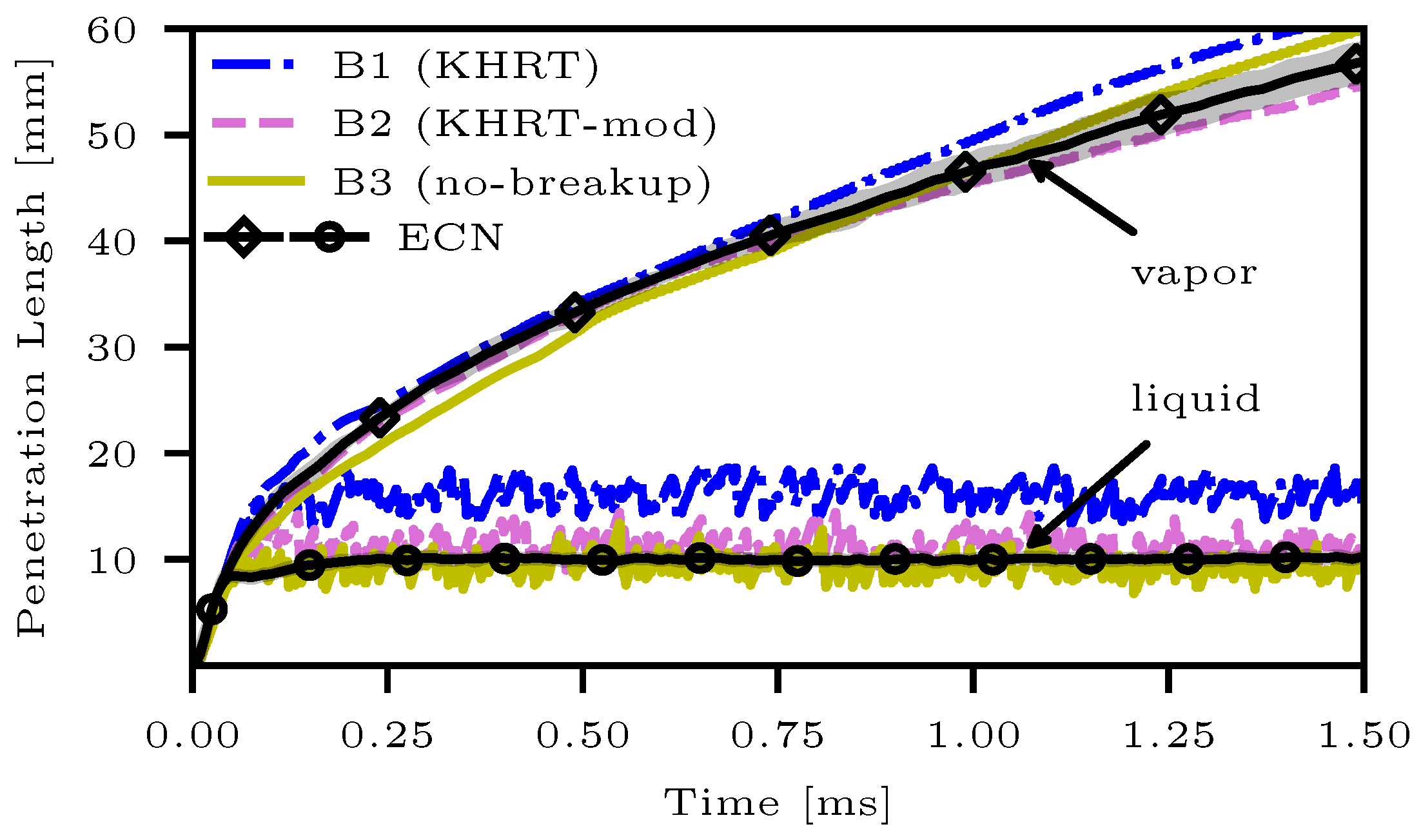



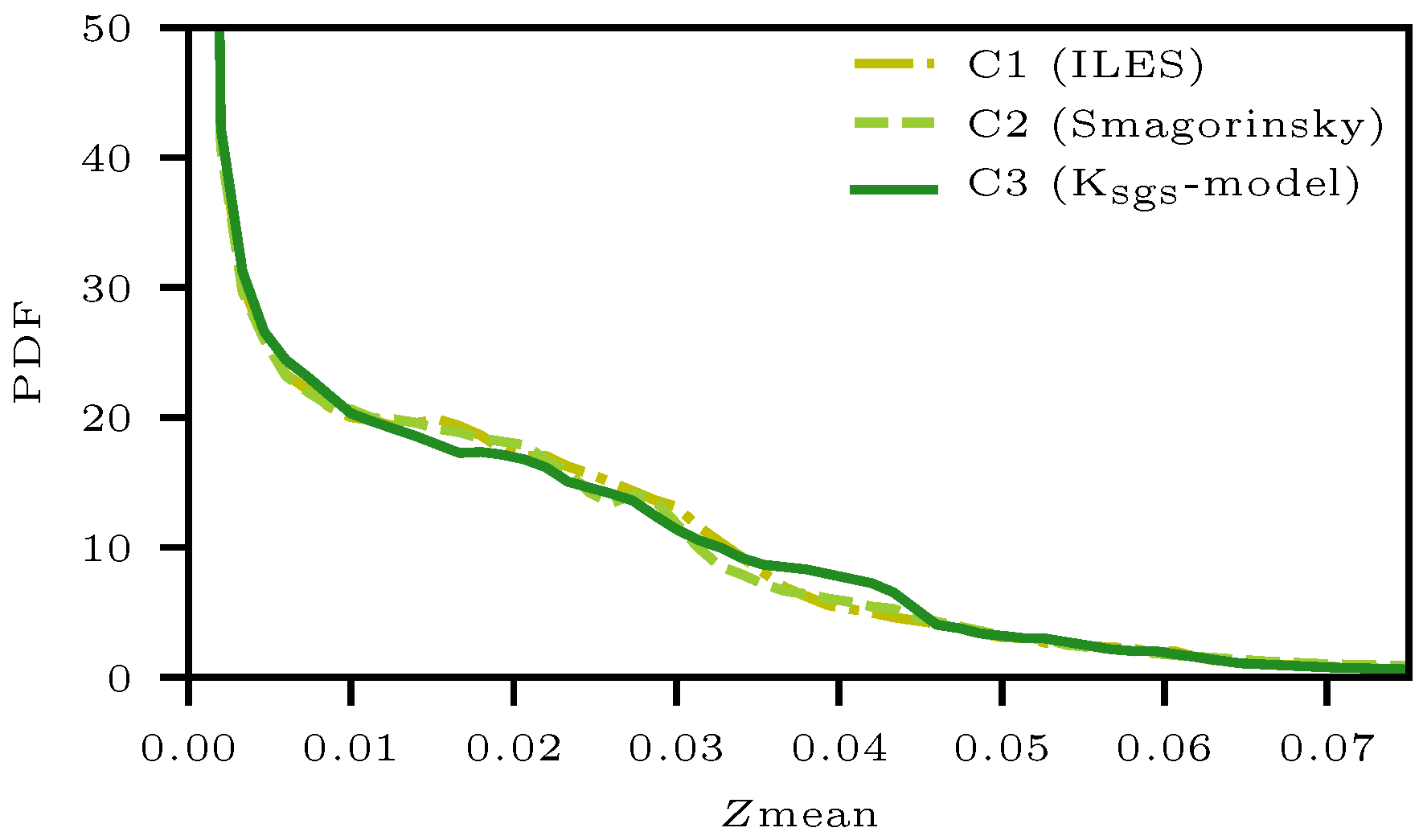

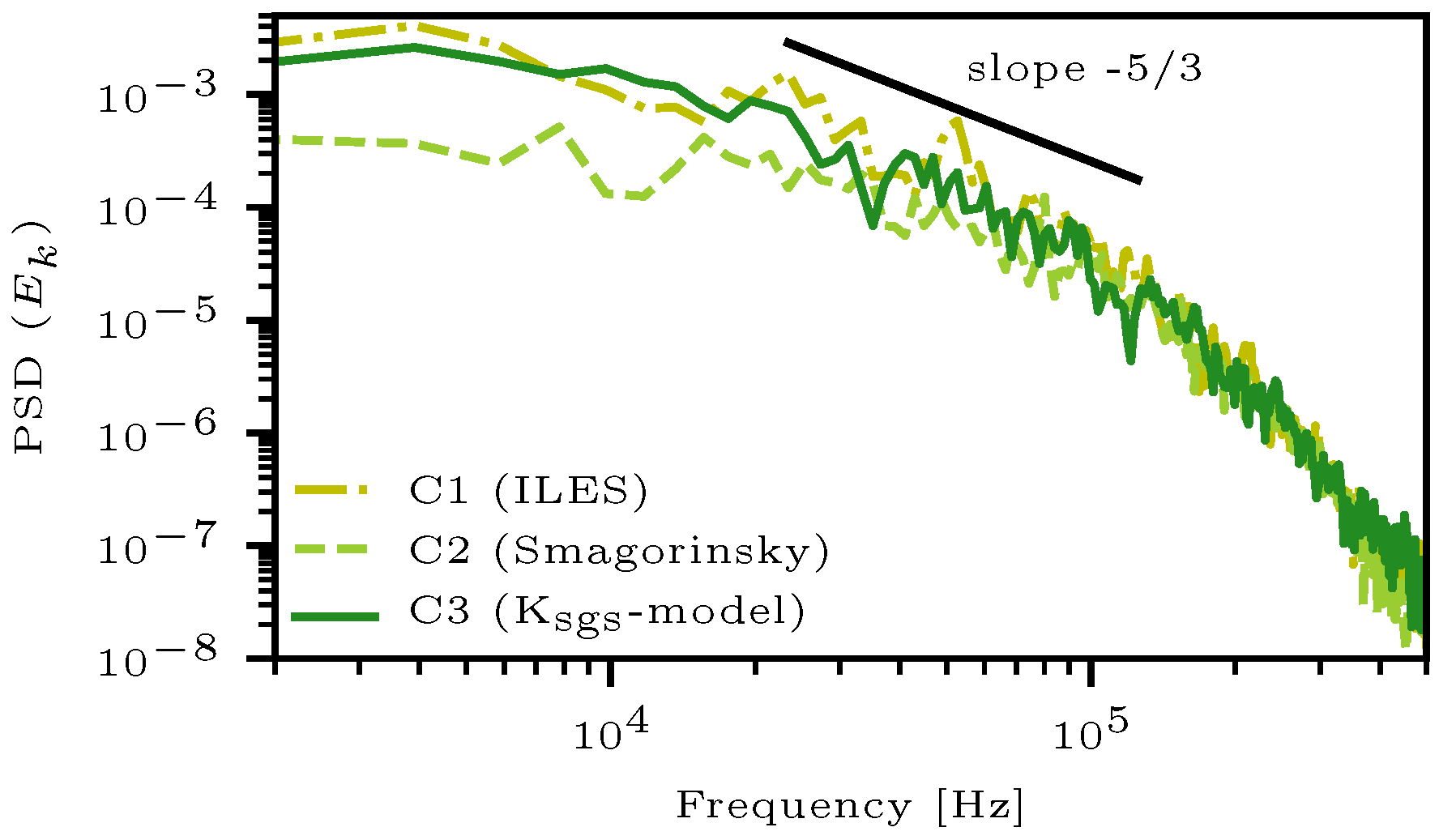
| ECN Spray A | ||
|---|---|---|
| T | [] | 900 |
| [] | 22.8 | |
| Fuel | n-dodecane | |
| T | [] | 363 |
| P | [] | 150 |
| [] | 1.5 | |
| [] | 90 | |
| O2 | [] | 0.0 |
| N2 | [] | 89.71 |
| CO2 | [] | 6.52 |
| H2O | [] | 3.77 |
| KHRT | 40 | 1 | 6 | |||
| KHRT-mod | 7 | 1 | 6 |
| Breakup | SGS | |||||
|---|---|---|---|---|---|---|
| STUDY-I | ||||||
| A1 | KHRT | ILES | 3.6 | |||
| A2 | KHRT | ILES | 7.2 | |||
| A3 | KHRT | ILES | 14.4 | |||
| A4 | KHRT | ILES | 7.2 | |||
| A5 | KHRT | ILES | 7.2 | |||
| STUDY-II | ||||||
| B1 | KHRT | ILES | 7.2 | |||
| B2 | KHRT-mod | ILES | 7.2 | |||
| B3 | no-breakup | ILES | 7.2 | |||
| STUDY-III | ||||||
| C1 | no-breakup | ILES | 7.2 | |||
| C2 | no-breakup | Smag. | 7.2 | |||
| C3 | no-breakup | K-model | 7.2 |
© 2020 by the authors. Licensee MDPI, Basel, Switzerland. This article is an open access article distributed under the terms and conditions of the Creative Commons Attribution (CC BY) license (http://creativecommons.org/licenses/by/4.0/).
Share and Cite
Gadalla, M.; Kannan, J.; Tekgül, B.; Karimkashi, S.; Kaario, O.; Vuorinen, V. Large-Eddy Simulation of ECN Spray A: Sensitivity Study on Modeling Assumptions. Energies 2020, 13, 3360. https://doi.org/10.3390/en13133360
Gadalla M, Kannan J, Tekgül B, Karimkashi S, Kaario O, Vuorinen V. Large-Eddy Simulation of ECN Spray A: Sensitivity Study on Modeling Assumptions. Energies. 2020; 13(13):3360. https://doi.org/10.3390/en13133360
Chicago/Turabian StyleGadalla, Mahmoud, Jeevananthan Kannan, Bulut Tekgül, Shervin Karimkashi, Ossi Kaario, and Ville Vuorinen. 2020. "Large-Eddy Simulation of ECN Spray A: Sensitivity Study on Modeling Assumptions" Energies 13, no. 13: 3360. https://doi.org/10.3390/en13133360
APA StyleGadalla, M., Kannan, J., Tekgül, B., Karimkashi, S., Kaario, O., & Vuorinen, V. (2020). Large-Eddy Simulation of ECN Spray A: Sensitivity Study on Modeling Assumptions. Energies, 13(13), 3360. https://doi.org/10.3390/en13133360







